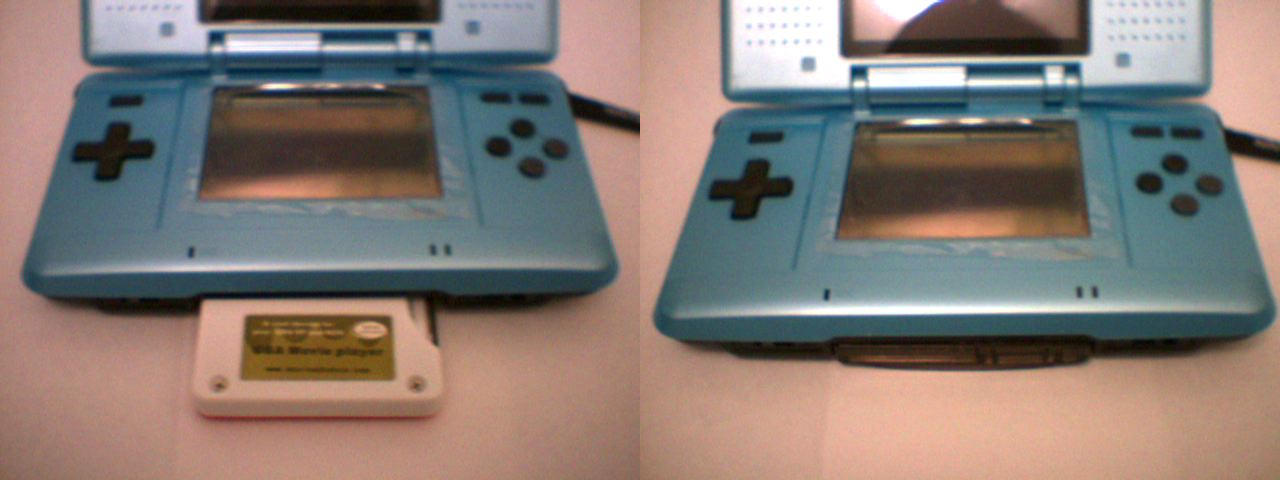Chapter 2
How do I get programs into my Nintendo DS?
The Methods
There are a few ways of getting your code into the Nintendo DS or DSi. The preferred method depends on which device you own. You will need a flash cart device if you own a Nintendo DS, but you don't need more than a regular SD card if you own a Nintendo DSi.
Flash carts are devices that have the shape of a regular DS game, except that they contain a microSD slot for you to add your own files. There are plenty of slot-1 devices, and all of them work in regular Nintendo DS consoles.
There is also the option of using slot-2 devices, but they are hard to find, and a bit awkward to use. Check Appendix C for more information about how they work.
If you own a Nintendo DSi it's a bit different. You can use slot-1 devices, but only the most modern ones. Nintendo DS consoles don't have very advanced protection systems, but Nintendo DSi consoles are much better at detecting unauthorized devices. Only a few slot-1 devices are still supported.
However, slot-1 devices aren't needed if you own a Nintendo DSi! There are ways to modify your console using software to load unauthorized code from the SD card slot of the console. This means that you don't need to buy anything at all! There are guides online that teach you how to do this.
Which Slot-1 Device should I buy?
As there are no homebrew produced devices made by homebrew people for homebrew people (yet), we regretfully have to buy devices designed and sold for piracy when buying NoPass or Slot-1 devices. That said, the most important feature to consider when buying one of these devices is DLDI support.
What is DLDI?
DLDI stands for dynamically linked device interface. In order for the homebrew filesystem, known as libfat, to work, you'll need a device which supports the DLDI standard. DLDI specifies a system by which DLDI modules can be dynamically loaded into homebrew software. This allows developers to release one version of their homebrew which the software end users simply patch and then run on a device of their choice. If you buy a device that does not support DLDI, you will be out of luck when wanted to run a majority of the homebrew applications and games out there. Not to mention that the company producing the device is essentially saying, "We don't need to spend time catering to the homebrew community since our device is designed just for piracy." We'd be better off not supporting that kind of company with our business.
You can learn more about DLDI and how to use it at the DLDI Wiki website, http://dldi.drunkencoders.com/index.php?title=Main_Page.
Where do I get one of these Slot-1 devices?
Out of the many places to buy these devices, I've been most happy with electrobee. electrobee is run by a trusted member of the homebrew community and ships worldwide from good ol' Canada (as opposed to who knows where). Their prices are quite often the best, too.
The Slot-2 Device of Choice
If you decide that GBA software development is important for you, you might want to consider getting a NoPass and a Slot-2 device. The NoPass will allow you to run Nintendo DS software from your Slot-2 device. The Slot-2 device, on its own, will be able to run GBA software. If you only care about Nintendo DS software, a Slot-1 device will meet your needs well, and you can skip the rest of this chapter.
The GBA Movie Player is a wonderful device which can run your software from a Compact Flash card. Compact Flash cards are very cheap and in high supply. If you have more SD cards than CF cards around, unfortunately, the only way to run NDS software from an SD card at this time is with the SD versions of the SuperCard or M3 Adapter. The GBAMP also sticks out from the bottom of the Nintendo DS a little, as shown in Figure 2.1, “Comparison of GBAMP (left) and a GBA flash cart (right) inserted into a DS”.
Figure 2.1. Comparison of GBAMP (left) and a GBA flash cart (right) inserted into a DS

With the GBA flash cart, the process of loading your programs into memory is a bit slow. Also, each GBA flash cart writer is specific to certain carts and often have closed source drivers. This means that most flash carts will be incompatible with Linux or Macintosh computers. In actuality, the only good thing about a GBA flash cart is that it does not stick out from the Nintendo DS, as can be seen in Figure 2.1, “Comparison of GBAMP (left) and a GBA flash cart (right) inserted into a DS”.
Running Multiple Software Titles
If you chose to go with the GBA flash cart, you can use a utility called Darkain’s MultiNDS Loader to load multiple programs onto your flash cart. This way, you don’t have to re-flash your cart each time you want to run a different application.
If you chose to go with the GBAMP, then I’d highly recommend DragonMinded's DSOrganize. It supports booting multiple programs, text editing, address books, calendars, and more. It's a great application for the DS. You can get it from http://www.dragonminded.com/?loc=ndsdev/DSOrganize. However, you cannot use a stock GBAMP to run NDS programs. You have to flash it with some custom firmware. Instructions and firmware are available from http://chishm.drunkencoders.com/NDSMP/index.html.
As for Slot-1 devices, these all usually come with their own menu systems (often incorrectly referred to as operating systems). You won't have to do anything special to run multiple software titles.